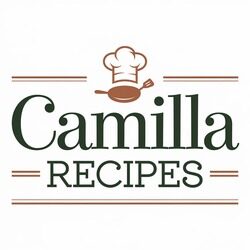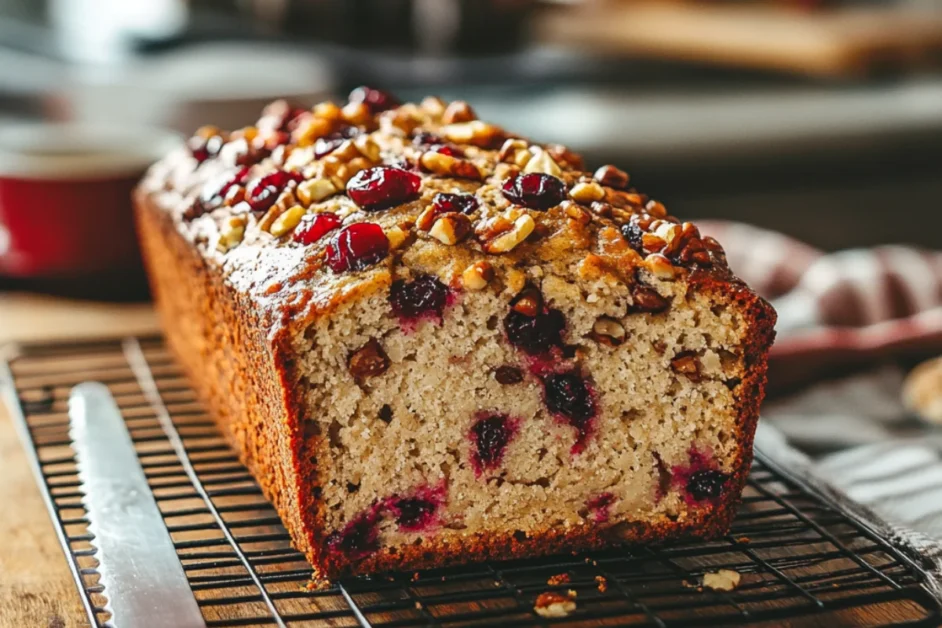Cranberry walnut bread is a delicious, hearty, and nutrient-packed quick bread that has been a favorite in many households for generations. The combination of tart cranberries and crunchy walnuts creates a perfect balance of flavors and textures, making it an excellent choice for breakfast, snacks, or even holiday gifts.
This bread has roots in traditional New England baking, where cranberries are a staple ingredient. With its naturally vibrant color and slightly tangy taste, cranberries add a refreshing contrast to the nutty, rich flavor of walnuts. Whether you’re an experienced baker or a beginner, this simple homemade recipe will quickly become a go-to favorite.
Why You’ll Love This Recipe
There are countless reasons to fall in love with homemade cranberry walnut bread. From its mouthwatering taste to its nutritional benefits, here’s why this recipe deserves a spot in your kitchen:
- Flavor & Texture: The contrast of tangy cranberries, earthy walnuts, and subtly sweet bread creates an explosion of flavors in every bite. The soft, moist crumb combined with the slight crunch of walnuts makes this bread incredibly satisfying.
- Health Benefits: Cranberries are rich in antioxidants, vitamin C, and fiber, making them a powerhouse for boosting immunity and promoting gut health. Walnuts, on the other hand, provhttps://en.wikipedia.org/wiki/Vitamin_Cide healthy fats, omega-3s, and protein, which contribute to heart health and brain function.
- Perfect for Any Occasion: This bread is versatile—it can be served as a quick breakfast with a pat of butter, a healthy afternoon snack, or a comforting treat alongside a cup of tea or coffee.
- Customizable: You can easily modify this recipe to suit dietary preferences by using different flours, sweeteners, or dairy substitutes.
Ingredients Overview
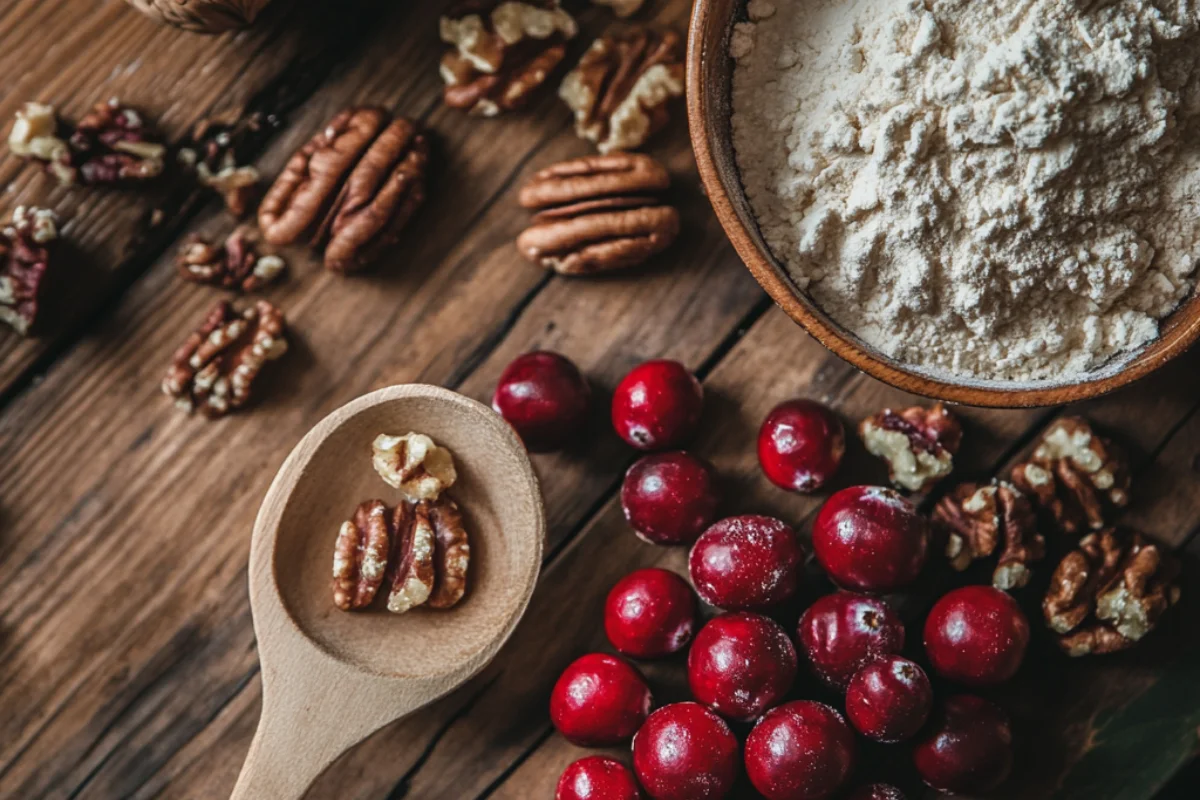
To create the perfect cranberry walnut bread, it’s important to use high-quality ingredients that complement each other. Below is a breakdown of each ingredient and its role in the recipe.
Choosing the Right Flour
Flour plays a key role in determining the texture and structure of your bread. Here are the best options:
- All-Purpose Flour: The most common choice, providing a soft and light texture.
- Whole Wheat Flour: Adds a nutty flavor and extra fiber, though it makes the bread slightly denser.
- Gluten-Free Flour: A blend of rice flour, almond flour, or oat flour works best for those avoiding gluten.
Types of Cranberries
The choice between fresh and dried cranberries can affect the final flavor and texture of your bread.
- Fresh Cranberries: Offer a tangy bite and a burst of juiciness when baked. However, they must be chopped before use to distribute flavor evenly.
- Dried Cranberries: Provide a chewier texture and sweeter taste. Soaking them in warm water or juice before adding them to the batter helps maintain moisture.
Selecting the Best Walnuts
Walnuts add an earthy, crunchy texture that complements the soft bread. The way you prepare them can alter the taste.
- Raw Walnuts: Mild and slightly bitter, perfect for a more natural taste.
- Toasted Walnuts: Enhances the nutty flavor and adds depth, making them a preferred option for many bakers.
Sweeteners and Alternatives
Different sweeteners can be used depending on your preference for taste and health benefits.
- White Sugar: Creates a classic sweetness with a lighter crumb.
- Brown Sugar: Adds richness and moisture due to its molasses content.
- Honey: A natural alternative with floral notes, but it may slightly alter the texture.
- Maple Syrup: Provides a mild caramel flavor and pairs well with walnuts.
Dairy or Non-Dairy Options
The choice of liquid ingredients can impact the moisture and richness of the bread.
- Buttermilk: Helps create a tender, moist crumb and adds a slight tang.
- Yogurt: Provides a creamy texture and enhances the bread’s richness.
- Almond Milk: A great dairy-free alternative that keeps the bread light.
Additional Flavor Enhancements
Enhancing the flavor of cranberry walnut bread is easy with a few extra ingredients:
- Orange Zest: Adds citrusy brightness that complements the tartness of cranberries.
- Cinnamon & Nutmeg: Bring warmth and depth to the bread.
- Vanilla Extract: Adds a sweet, aromatic flavor that balances all the ingredients.
Essential Kitchen Tools
Before diving into the baking process, having the right tools on hand ensures a smooth experience:
- Mixing Bowls: Essential for combining wet and dry ingredients separately.
- Loaf Pan: A 9×5-inch loaf pan works best for an evenly baked bread.
- Measuring Cups & Spoons: Ensure accurate ingredient portions for the perfect consistency.
- Whisk & Spatula: Helps incorporate ingredients gently without overmixing.
- Stand Mixer or Hand Mixer: Useful for blending wet ingredients effortlessly.
- Cooling Rack: Allows proper airflow, preventing a soggy bottom after baking.
Step-by-Step Guide to Making Cranberry Walnut Bread
Baking cranberry walnut bread at home is a rewarding experience, filling your kitchen with the warm, inviting aroma of nuts and fruit. This guide will take you through the entire process—from preparing ingredients to serving up a delicious slice. Whether you’re a beginner or an experienced baker, these step-by-step instructions will ensure a perfect loaf every time.
Preparing the Ingredients
Before mixing your dough, it’s essential to properly prepare your ingredients to ensure an even texture and distribution of flavors.
Measuring Ingredients Accurately
- Use measuring cups for dry ingredients and liquid measuring cups for wet ingredients.
- Spoon and level flour instead of scooping to avoid excess flour, which can make the bread dry.
- Measure sweeteners carefully to balance the tartness of the cranberries and richness of the walnuts.
Chopping Cranberries and Walnuts
- Fresh Cranberries: Chop them into halves or quarters for better distribution. This prevents large sour pockets in the bread.
- Dried Cranberries: If using dried cranberries, soak them in warm water, orange juice, or rum for 10-15 minutes to rehydrate and add extra flavor.
- Walnuts: If using whole walnuts, chop them into small, bite-sized pieces to ensure even distribution.
Mixing the Dough
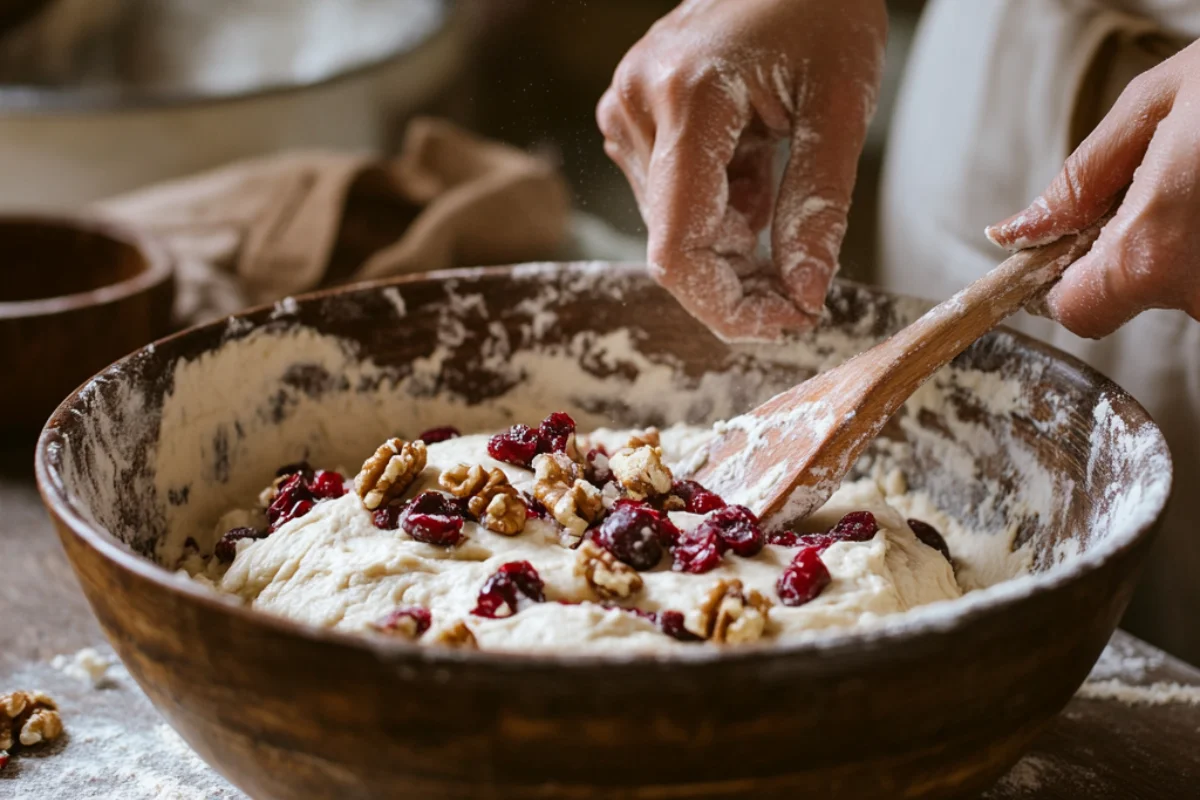
A well-mixed dough is the foundation of moist, fluffy bread. Follow these steps to get the perfect consistency.
Combining the Dry Ingredients
- In a large mixing bowl, whisk together:
- Flour (all-purpose, whole wheat, or gluten-free)
- Baking powder and baking soda for leavening
- Salt to enhance the flavors
- Optional: Cinnamon or nutmeg for extra warmth
Mixing the Wet Ingredients
- In a separate bowl, whisk together:
- Eggs for structure
- Sugar (or chosen sweetener) for sweetness and moisture
- Buttermilk, yogurt, or almond milk for softness
- Melted butter or oil for richness
- Vanilla extract for depth of flavor
Bringing It All Together
- Gradually add the wet ingredients to the dry ingredients, stirring gently with a spatula.
- Mix until just combined—overmixing can lead to dense, tough bread.
How to Properly Fold in Cranberries and Walnuts
Properly incorporating mix-ins ensures they don’t sink to the bottom or clump together.
- Sprinkle the chopped cranberries and walnuts with a small amount of flour before adding them. This prevents them from sinking during baking.
- Use a spatula or wooden spoon to gently fold them into the batter. Avoid overmixing, as this can cause the bread to become tough.
Proofing and Resting Time
Unlike yeast-based breads, cranberry walnut bread is a quick bread that doesn’t require traditional proofing. However, a short resting period can improve the texture.
- Let the batter sit for 5-10 minutes before baking to allow the flour to hydrate.
- If using whole wheat or gluten-free flour, let the mixture rest for 15-20 minutes to prevent grittiness.
Baking the Bread to Perfection
Ideal Baking Temperature and Time
- Preheat your oven to 350°F (175°C) for even baking.
- Grease a 9×5-inch loaf pan or line it with parchment paper.
- Pour the batter into the pan and smooth the top with a spatula.
Testing for Doneness
- Bake for 50-60 minutes or until a toothpick inserted in the center comes out clean.
- If the top browns too quickly, cover it with foil during the last 15 minutes of baking.
Cooling and Storing Tips
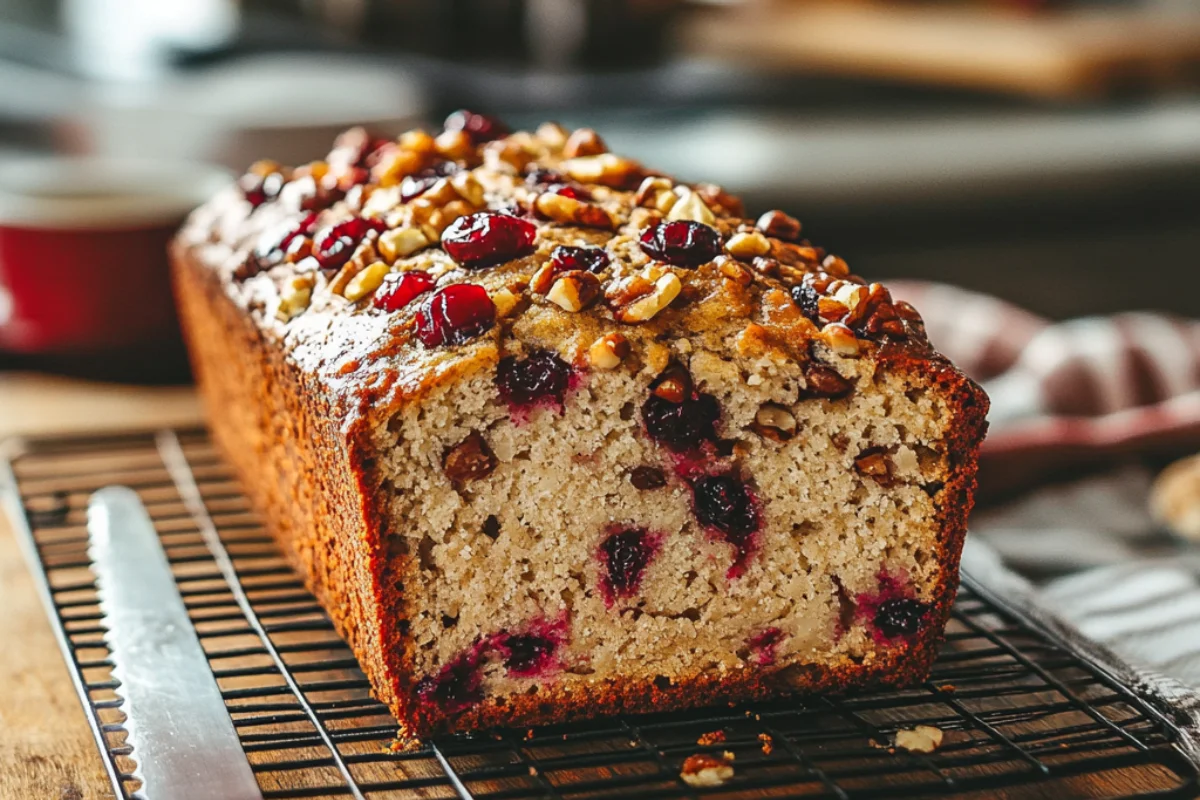
Proper cooling and storage will keep your cranberry walnut bread moist and fresh.
Cooling Properly
- Let the bread cool in the pan for 10 minutes before transferring it to a wire rack.
- Avoid slicing immediately—this helps retain moisture.
Best Storage Methods
- Room Temperature: Wrap in plastic wrap or store in an airtight container for up to 3 days.
- Refrigerator: Store in the fridge for up to a week, but bring to room temperature before eating.
- Freezer: Slice the bread and freeze individual portions wrapped in foil for up to 3 months.
Variations of Cranberry Walnut Bread
This recipe is highly adaptable! Try these variations to suit different dietary needs:
- Whole Wheat Version: Use 50% whole wheat flour and 50% all-purpose flour to maintain a tender texture.
- Gluten-Free Version: Replace flour with a gluten-free baking blend.
- Vegan Version: Substitute eggs with flaxseed eggs and use almond milk instead of dairy.
- Low-Sugar Version: Reduce sugar by half and add extra vanilla or orange zest for natural sweetness.
Adding a Sweet or Savory Twist
Want to elevate your cranberry walnut bread? Try these delicious add-ins:
Sweet Enhancements
- Cream Cheese Swirls: Mix softened cream cheese with a bit of sugar and swirl it into the batter before baking.
- Streusel Topping: Combine brown sugar, flour, and butter for a crunchy topping.
Savory Additions
- Herb-Infused: Add rosemary, thyme, or sage for a more savory, complex flavor.
- Cheese Blend: Mix in grated cheddar or parmesan for a cheesy contrast.
How to Serve & Pair Your Bread
Cranberry walnut bread is delicious on its own, but pairing it with complementary spreads and sides can take it to the next level.
Best Pairings
- Butter & Jams: Spread with butter, honey, or cranberry jam for extra flavor.
- Cheese Board Addition: Serve with brie, goat cheese, or cream cheese for a gourmet touch.
- Soup & Salad Side: Pair with butternut squash soup or a fresh spinach salad for a balanced meal.
Nutritional Breakdown of Cranberry Walnut Bread
Cranberry walnut bread is not just delicious, but it also provides a good balance of macronutrients and essential vitamins. While it is slightly indulgent, its combination of fiber-rich cranberries and heart-healthy walnuts makes it a better-for-you treat. Let’s break down the nutritional content per one slice (approximately 1-inch thick, from a standard 9×5-inch loaf):
Estimated Nutrition Per Slice (based on a traditional recipe)
- Calories: ~200-250 kcal
- Carbohydrates: ~30-35g
- Protein: ~4-6g
- Fat: ~10-12g (mainly from walnuts)
- Fiber: ~2-3g
- Sugars: ~12-15g (varies based on sweetener choice)
- Cholesterol: ~15-30mg (if using eggs and butter)
Note: The nutritional values will vary depending on ingredient substitutions (e.g., whole wheat flour, less sugar, dairy-free options).
Health Benefits of Cranberries and Walnuts
This bread is more than just a treat—it’s packed with nutrient-dense ingredients that offer a variety of health benefits.
Cranberries: A Superfood for Immunity & Digestion
- Rich in Antioxidants: Cranberries contain polyphenols that help fight inflammation and protect against oxidative stress.
- Supports Urinary Health: Cranberries are known to help prevent UTIs by reducing harmful bacteria in the bladder.
- Boosts Digestive Health: The fiber in cranberries aids in gut health and promotes regular digestion.
Walnuts: Brain & Heart-Boosting Nutrients
- Excellent Source of Omega-3s: Walnuts provide alpha-linolenic acid (ALA), a plant-based omega-3 that supports heart and brain function.
- May Help Reduce Inflammation: The antioxidants in walnuts, including vitamin E, help combat chronic inflammation.
- Aids in Brain Health: Studies suggest that walnuts may enhance cognitive function and reduce the risk of neurodegenerative diseases.
How to Make the Recipe Healthier
Want to enjoy cranberry walnut bread guilt-free? Here are some simple swaps to reduce sugar, increase fiber, and make it dairy-free:
Cutting Sugar Without Sacrificing Flavor
- Reduce white sugar by 25-50% and use natural sweeteners like honey, maple syrup, or mashed bananas.
- Add orange zest or vanilla extract for natural sweetness.
Choosing Whole Grains
- Swap all-purpose flour for 50% or 100% whole wheat flour for added fiber.
- Use oat flour for a softer texture and more nutrients.
Dairy-Free Options
- Replace buttermilk with almond milk + 1 tsp vinegar for the same tangy effect.
- Use coconut oil or vegan butter instead of dairy butter.
Common Mistakes and Troubleshooting
Even experienced bakers run into issues. Here’s how to avoid and fix common cranberry walnut bread problems:
1. Dense or Tough Bread
Possible Causes:
- Overmixing the batter → gluten overdevelopment.
- Using too much flour → dry and heavy texture.
How to Fix:
- Mix only until combined.
- Spoon and level flour properly to avoid excess.
2. Soggy or Undercooked Bread
Possible Causes:
- Oven temperature too low.
- Removing the bread from the oven too early.
How to Fix:
- Bake at 350°F (175°C) for at least 50-60 minutes.
- Use a toothpick test—if it comes out clean, the bread is done.
3. Burnt Edges with an Undercooked Center
Possible Causes:
- Oven too hot or incorrect pan size.
- Bread placed too close to the heating element.
How to Fix:
- Reduce the temperature by 25°F (15°C) and cover the top with foil after 30 minutes.
- Use a light-colored metal loaf pan for even baking.
How to Store and Freeze Cranberry Walnut Bread
Proper storage ensures your bread stays fresh and moist.
Short-Term Storage (1-3 Days)
- Keep in an airtight container at room temperature.
- Avoid refrigerating as it can dry out the bread.
Refrigeration (Up to 1 Week)
- Wrap the bread in plastic wrap and place it in the fridge.
- Bring it to room temperature before serving for the best texture.
Freezing (Up to 3 Months)
- Wrap slices individually in plastic wrap, then place in a freezer-safe bag.
- To reheat, microwave for 20-30 seconds or toast lightly.
Can You Make This Bread in a Bread Machine?
Yes! With a few modifications, you can make cranberry walnut bread in a bread machine.
Adjustments for Bread Machines
- Use the “Quick Bread” or “Cake” setting.
- Mix wet and dry ingredients separately, then combine just before starting the cycle.
- Add cranberries and walnuts during the last kneading cycle to prevent them from sinking.
How to Make Cranberry Walnut Muffins Instead
Transform your loaf into muffins for a portable, grab-and-go option!
Recipe Adjustments
- Use a muffin tin lined with paper liners.
- Reduce baking time to 18-22 minutes at 350°F (175°C).
- Check doneness with a toothpick—it should come out clean.
Festive and Holiday Variations
Make your cranberry walnut bread extra special for the holidays!
Christmas & Thanksgiving
- Add white chocolate chips for a sweet festive touch.
- Use pecans instead of walnuts for a richer taste.
Easter & Springtime
- Swirl in cream cheese for a cheesecake-like flavor.
- Add lemon zest for a refreshing twist.
Frequently Asked Questions (FAQs)
1. Can I use frozen cranberries?
Yes! No need to thaw—just toss them in a bit of flour before mixing to prevent color bleeding.
2. Can I use other nuts?
Absolutely! Pecans, almonds, or hazelnuts work well as substitutes for walnuts.
3. Why did my cranberries sink?
Coat them in flour before adding to the batter—this helps distribute them evenly.
4. How do I make this bread egg-free?
Use flax eggs (1 tbsp flaxseed meal + 3 tbsp water per egg) as a vegan alternative.
5. What’s the best way to prevent dryness?
Use oil instead of butter and add an extra tablespoon of yogurt or applesauce.
Final Thoughts and Serving Suggestions
Baking homemade cranberry walnut bread is a simple yet satisfying experience. Whether you’re enjoying it as a cozy breakfast or sharing it with loved ones during the holidays, this recipe offers versatility, flavor, and nutrition.
So go ahead—experiment with flavors, mix-ins, and flour variations to create your perfect loaf. Happy baking!
